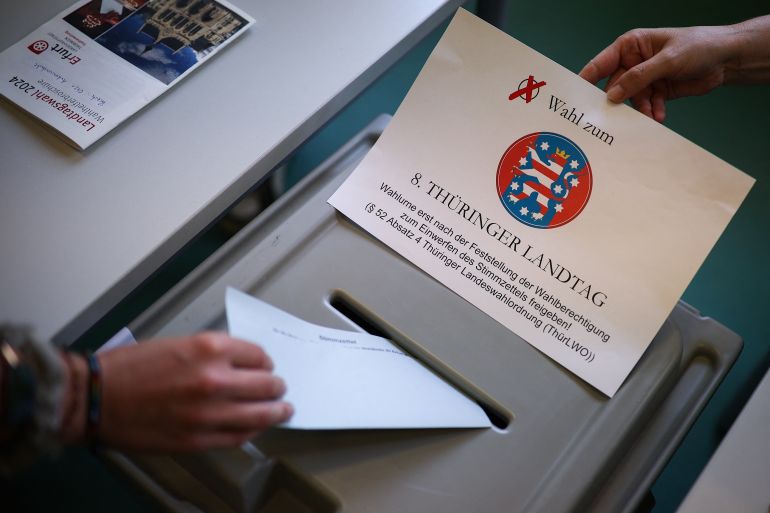Germany’s far-right party likely to make gains in eastern region elections
The anti-immigration Alternative for Germany (AfD) is likely to dominate Thuringia and Saxony polls, in a blow for Chancellor Olaf Scholz’s coalition.
A woman casts her ballot for Thuringia’s regional election at a polling station in Erfurt, eastern Germany [Ronny Hartmann/AFP]Published On 1 Sep 20241 Sep 2024
Voters in two German states are casting their ballots in an election expected to deal a blow to Chancellor Olaf Scholz’s government and deliver big gains for the far-right Alternative for Germany (AfD).
The Alternative for Germany (AfD) is likely to make major gains in Thuringia and Saxony in Sunday’s vote, being seen as a barometer to next year’s federal election.
Keep reading
list of 4 itemslist 2 of 4
Should we fear a far-right resurgence in Europe?
end of list
A win would mark the first time a far-right party has the most seats in a German state parliament since World War II. The 11-year-old party would not likely be able to form a state government even if it does win, as it is polling short of a majority and other parties refuse to collaborate with it.
The contests in the former East German states come just over a week after three people were killed in a knife attack that has fuelled a bitter debate over immigration in Germany.
Opinion polls had showed the anti-immigration AfD ahead in Thuringia and a close second in Saxony, while also predicting a strong showing for the upstart far-left Sahra Wagenknecht Alliance (BSW).
An election victory for the AfD would be a landmark in Germany’s post-war history and represent a rebuke for Scholz ahead of national elections in 2025.
In both the states, Scholz’s Social Democrats are polling at around six percent, while their coalition partners, the Greens and the liberal Free Democratic Party (FDP), lag even further behind.
Reporting from Berlin, Al Jazeera’s Dominic Kane said the polls will close at 16:00 GMT after which “the party that wins has the moral authority to say that ‘we represent East Germany’ or at least a large chunk of eastern Germany”.
He noted that some of the people voting in these two states had lived under communism 35 years ago.
‘Political turnaround through Germany’
Saxony is the most populous of the former East German states and has been a conservative stronghold since reunification. Thuringia is more rural and the only state currently led by the far-left Die Linke, a successor of East Germany’s ruling communist party.
Casting her vote early in Erfurt, the capital of Thuringia, Sandra Pagel told AFP news agency she was “really afraid” of a victory of the AfD.
“I’m very nervous to see what happens today … because I think there’s a very high risk that the AfD will win and that scares me. For my grandchildren and also for me,” said the 46-year-old sterilisation processing facility manager.
“I just hope that we get a coalition that is democratic and not right-wing at the end,” Naila Kiesel told Reuters after casting her ballot in the city of Jena in Thuringia.
Created in 2013 as an anti-euro group before morphing into an anti-immigration party, the AfD has capitalised on the fractious three-way coalition in Berlin to rise in opinion polls.
In June’s European Parliament elections, the party scored a record 15.9 percent overall and did especially well in eastern Germany, where it emerged as the biggest force.
In a post on social media platform X on Sunday, AfD co-leader Alice Weidel urged voters to choose the AfD to “not only change the future in Saxony and Thuringia, but also bring about a political turnaround throughout Germany”.
Alongside the AfD, new party BSW has also found a receptive audience in the eastern states for its criticism of the government in Berlin and of military aid to Ukraine.
Founded in January by the firebrand politician Sahra Wagenknecht after she quit Die Linke, BSW has made hay with a dovish stance towards Russia and calls for a radical crackdown on immigration.
The AfD and BSW together are expected to take some 40-50 percent of the vote in the two states compared with 23-27.5 percent at the national level, laying bare the continuing divide between East and West Germany, more than 30 years after reunification.
